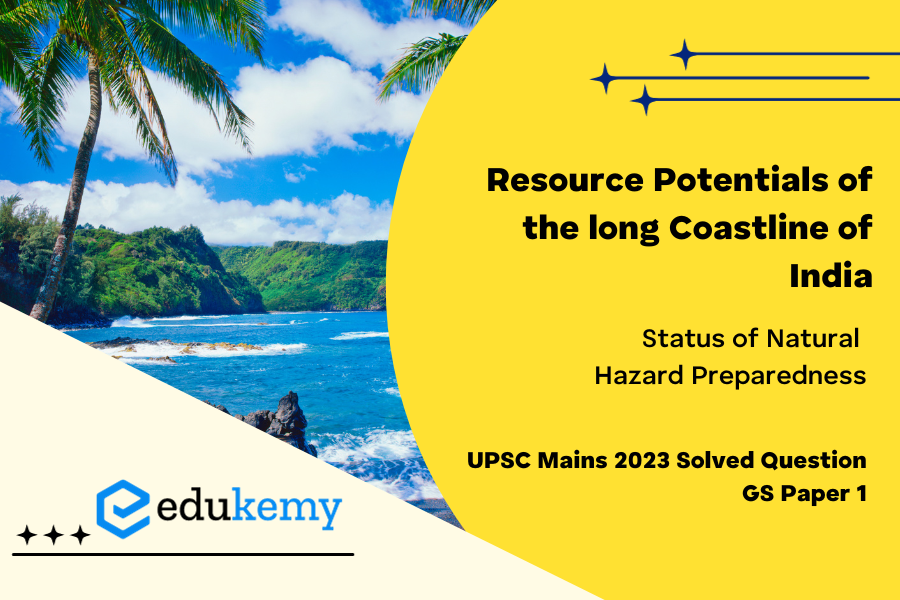UPSC Mains General Studies Paper – 1 Mains 2023
UPSC Mains Civil Services IAS Exam Question Paper – 2023
Contents
Introduction
India boasts a vast coastline extending 7,516 kilometers, offers a plethora of resource potentials, from fisheries to tourism, and plays a crucial role in India’s economic and environmental landscape. This expansive coastline also exposes the nation to various Natural Hazards, raising concerns about preparedness and resilience.
Body
Resource potential of Bengal-Orissa coastline region
- Fisheries: The region is a vital fishing hub, particularly in the Bay of Bengal, contributing significantly to India’s fish production and coastal livelihoods.
- Ports and Trade: Major ports like Paradip and Kolkata facilitate international trade, handling a substantial portion of India’s cargo.
- Minerals: Coastal Odisha is rich in minerals like iron ore, bauxite, and chromite, vital for the steel and aluminum industries.
- Agriculture: Fertile coastal plains support rice, pulses, and oilseed cultivation, aided by the Mahanadi River’s water resources.
- Renewable Energy: Coastal areas, especially Tamil Nadu and Andhra Pradesh, tap into wind and solar power, contributing to clean energy generation.
- Biodiversity: Coastal mangrove forests and wetlands provide crucial habitats and ecosystem services, including flood control and carbon sequestration.
- Industry and Manufacturing: The region hosts various industries, such as manufacturing and petrochemicals, facilitated by ports and transportation infrastructure.

Resource potential of Andhra- Tamil Nadu coastline region
- Biotic Potential -Andhra coast -In parts of Coringa WLS, East Godavari and Krishna river. Tamil Nadu coast-Pichavaram (Kollidam, uppanar river),Muthupet (Pamani river) and Ramnad Karan Kadu region etc. The Gulf of Manner is a marine biodiversity hotspot with unique species of coral and marine life like dugong aca sea cow.
- Fishery resources– Andhra Pradesh (27.4%) and West Bengal (13.8%) together produce about 41% of the country’s total fish production.
- Aquaculture– coastal regions are conducive to aquaculture, including shrimp and prawn farming.Example- Andhra Pradesh is a hub of shrimp farming along its coastal areas.
- Heavy Minerals– Coastal regions are abundant in heavy minerals like monazite,sillimanite and leucoxene.Example- The beaches of Andhra Pradesh and Tamil Nadu are known for their heavy mineral sands.
- Minerals resources – India’s coastline is rich in mineral resources, including limestone, silica, and garnet. Example: The coastal regions of Gujarat and Tamil Nadu are known for their limestone deposits used in the cement industry.
There are significantly three Hazards to which these coasts are vulnerable
1. Cyclones –
- Cyclone disaster management in India has seen significant progress in recent years in mitigating its impact .
- Cyclones along the Bay of Bengal – There is a decrease of 8% in cyclonic storms as compared to the previous period(1982-2000). However it still dominates in terms of cyclone frequency and intensity as compared to Arabian Sea.
- Cyclone along the Arabian Sea – less frequent but not less dangerous. There has been 52% increase in the number of cyclonic storms over the Arabian sea (2001-2019)
Preparedness :-
- Enhanced early warning systems.
- National cyclone risk Mitigation Project (NCRMP) supported by world bank
- Coastal protection initiatives like Mangrove plantations ex- Misti Scheme.
- Infrastructure Retrofitting
- Integrated coastal zone management (ICZM) project – it includes mapping vulnerable zones
- Cloud coding schemes done by IMD
- Cyclone shelters Examples – the destructive Cyclone Phailin in 2013 had minimal human casualties due to effective preparedness and evacuation efforts
2. Tsunami-
- They are the parts of Indian Ocean Tsunami system
- After the 2004 Indian Ocean tsunami, India has improved its tsunami warning systems and disaster response.
- Preparedness- Indian Tsunami early warning system (ITEWC) in Hyderabad issues timely efforts.
3. Sea level rise –
- The IPCC report noted that the global mean sea level in the Indian Ocean is rising at a rate of 3.7 metres per year and that extreme sea level events, which were previously seen roughly every year
- In the Indian Ocean half of sea level rise is due to the volume of water expanding since the ocean is warming up rapidly along with the increasing concentration of Co2 and other GHGs.
- Impacts like loss of coastal resources, salt water incursion, soil erosion, depletion
- In February 2021, McKinsey India had said in a report that by 2050, Mumbai will witness a 25 per cent increase in the intensity of flash floods accompanied by a half-metre rise in the sea-level, which could hit around two-three million people living “within a one-km radius of the city coastline”
Preparedness :-
- Coastal Regulation Zone
- National Action Plan on Climate change – Flood Management scheme of Ministry of Jal Shakti
- Switching from fossil fuels to clean alternatives like solar and wind energy
- Carbon sequestration – Coastal Management Information System (CMIS)
- Afforestation – compensatory Afforestation Fund Management and Planning Authority
Conclusion
Hence, the Indian coastline has a huge potential of resources in areas like fisheries, Tourism, rare earth minerals, poly metallic nodules, renewable energy etc. However these regions are also exposed to various climatic and anthropogenic hazards which are detrimental to above resources and human settlements. It’s high time to enhance our capabilities in terms of disaster preparedness and response to protect lives and resources.
In case you still have your doubts, contact us on 8792740517.
For UPSC Prelims Resources, Click here
For Daily Updates and Study Material:
Join our Telegram Channel – Edukemy for IAS
- 1. Learn through Videos – here
- 2. Be Exam Ready by Practicing Daily MCQs – here
- 3. Daily Newsletter – Get all your Current Affairs Covered – here
- 4. Mains Answer Writing Practice – here
Visit our YouTube Channel – here


